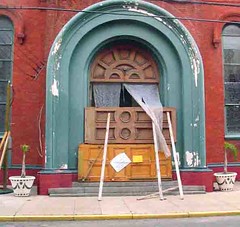new orleans is still new orleans...

the loblolly pines* were chopped off 10 to 20 feet above the ground, broken off like toothpicks.
"wow, damage from katerina," i thought. highway 59 south into new orleans was corridor of sawed off giant pine trunks.
then i noticed a mile-marker. in hattiesburg, mississippi i was still more than 108 miles from new orleans.
i saw boarded up gas stations with shattered signs, vacant malls with the siding blown off and miles and miles of crushed forest. even the scrub trees in the swamps were flattened by the winds of last august.
the giant "six flags" sign -- a hulk of empty metal struts by the highway near lake ponchatrain;
a holiday inn billboard, with only one panel intact;
a mileage marker "new orleans 23 miles" bent over at the base;
the hulking restaurant "pralines" had a big banner "yes, we're open!"
just beyond, a cluster of small signs by the side of the road advertised roofing and construction companies, insurance companies, tree and debris removal, churches and, of course, a "gentleman's club" featuring adult entertainment "now open and better than ever!" in new orleans there are still priorities.
the sun was setting over the lake as i entered new orleans. the sky all cloudyyellow and the huge sheet of water all bluegray. as highway 10 enters the city there is a terrific view of the city. and there it was, still there, an emerald city at the end of a yellow brick highway 10 -- but now with blue plastic tarps wrapped over multitudes of rooftops; like venice, new orleans is entered over water -- but a portion of the highway bridge is now out, replaced by a temporary steel truss with a wavering road bed.
i probably wont publish too many pictures of wrecked buildings. you can find them online.
but ive seen empty shells of buildings and intact buildings; wrecked cars in front of newly opened drug stores; boats on the sidewalks and newly painted cafes; shuttered churches and drive-thru daiquiri stands -- all of them exist side-by-side in a roughly 60 square mile swath -- thats the area that was flooded. it really is the worst natural disaster in united states history.
from what i can see, it isnt an all-white city just yet. the devastation affected the black community disproportionately of course, but there are black and white neighborhoods that were almost completely destroyed. there are poor neighborhoods with huge numbers of empty buildings, there are middle class neighborhoods that are entirely uninhabitable. black and white, rich and poor, they were all affected. not even half of them have returned. but its still new orleans.
here is a picture of a church in the 9th ward. it is, and will be, apparently abandoned. i am staying in the bywater area of the 9th ward for the next week and a half.
i walked by a huge pile of old refrigerators, garbage and debris soon after arriving here. there were several large dead dogs, very decomposed, in the pile.
i am told that there are over 2,000 people unaccounted for here in the city.
some of the more sarcastic crewes this year have already thrown floating key-chains into the crowd. "jaques chirac, buy us back" they chanted.
a good bumper sticker: "new orleans, proud to swim home" (this is a play on "new orleans, proud to call it home," or "new orleans, proud to crawl home.")
ive eaten a fried oyster po-boy sandwich (pronounced, "er-ster"). ive watched circus performers present a cabaret in an artists loft with electric guitars, a trumpet and a banjo, ive been called "darling" by a middle aged woman at the grocery check-out, and "baby" by a clerk in a hardware store. (very new orleans)
this is still new orleans. this is mardi gras week. 60 percent of the residences in the city are not inhabitable. it seems to me like at least half the stores are closed.
another bumper sticker: "the big easy aint easy anymore."
_______________
*Pinus taeda, the loblolly pine, also known as the Arkansas, North Carolina, or oldfield pine, belongs to the yellow pine group. Its native range extends from southern New Jersey to Florida, and as far west as Texas. This rapidly growing tree thrives in the maritime forest in a variety of soils, including well-drained upland areas with poor nutrient concentrations to poorly drained lowland areas and abandoned fields. It prefers relatively long, hot and humid summers and adapts well to tree farm environments. The loblolly is one of the fastest growing pines, and is often chosen to use for convenient landscape screening. The tree grows rapidly and can reach 100 feet tall. It is particularly prized for its straight trunk, which contains no knots for up to 30 feet. Early colonists used the tree's resin to boil into pitch or tar.
http://www.chesapeakebay.net/info/loblolly.cfm

0 Comments:
Post a Comment
<< Home